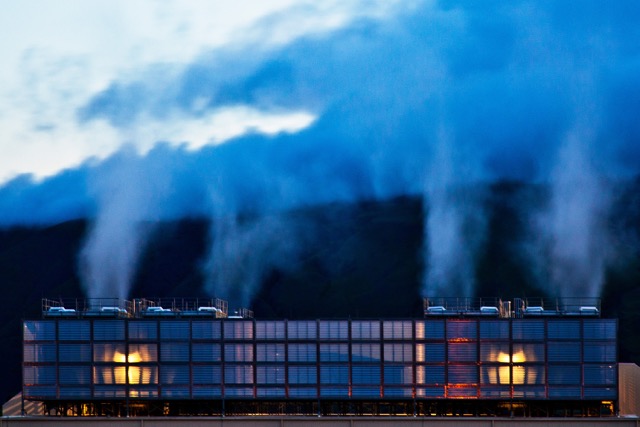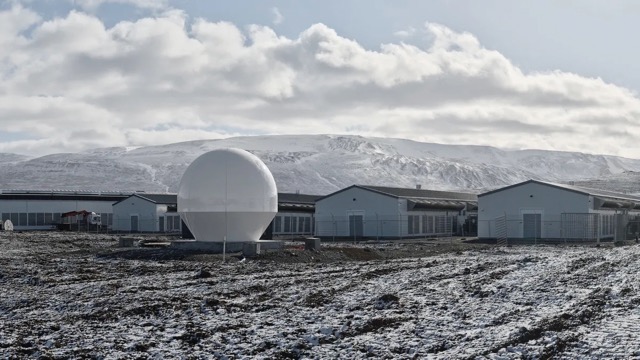Data centers are in the news. You have probably read or heard about them. It’s as if with the snap of a finger the news cycle has changed, and the latest trend is to focus on the need to develop infrastructure to power data centers, in the US at least, where one of us is writing from. A data center is a facility where data is processed or stored, or where computer power is redistributed, where “the cloud touches the ground” (Johnson 2023: 6-7). By focusing on the history of the data centers we research, our goal in this piece is to demonstrate how they are built on top of existing infrastructures, and do not exist in thin air.
This story also highlights multiple meanings of connection in a sensitive moment in which tensions are heightened between two AI superpowers (China, US) and a new tech oligarchy (aka “broligarch”) which has overarching power not only on topics related to computers, tech and AI, but migrates into other spheres of public policy and government. While most news outlets write as if there is one single truth to pursue, and the internet is either evil or good, as scientists, we obviously reject this simple and unilateral narrative. Bear with us as we reflect on the multiple meanings of connection in the languages we work with (Portuguese, English, and Danish) to propose a different way of looking at our current tech landscape and to think about academic collaboration.
Connection in the Present
In Portuguese, the word for connection is conexão, in Danish, the word is forbindelse which can be translated to English as “relation/relationship.” We met in the summer of 2024, and have been cultivating an academic and friendly relationship ever since. Our interaction and academic collaboration is made possible thanks to the cloud and other digital networks we currently research. We were introduced via email by a professor based in Copenhagen who recognized the similarities of our work, backgrounds and research interests. We are both Brazilians, come from a similar socioeconomic background and are around the same age. We both studied social sciences and anthropology in public universities in Brazil and are now living in the US and Europe to pursue our PhDs in anthropology. As if there weren’t enough similarities already, our research topics are almost the same (yes, we were shocked to learn about that!): we focus on data centers in their relationship with their local environments. But what does connection actually mean in a time where digital infrastructures destroy the environment and hinder connections beyond the digital realm?
Ana’s PhD research explores how current data centers in Oregon are part of a deeper industrial history made possible thanks to infrastructural projects developed during the Great Depression, when New Deal policies enforced the need to focus on big projects that would employ a large number of people (Brown 2013). For example, in the 1930s, the federal government through its Army Corps of Engineers started to build dams in the Columbia River, and these dams have generated hydropower that even today is appealing to a “power hungry” industry, such as data centers. Other industries have also benefited from such power, such as aluminum smelting. Even Boeing in the neighboring state of Washington has deeply benefitted from the energetic capacity of the Columbia River, harnessed through its multiple dams (Durbin 2013). A similar connection to pre-existing infrastructure is also the case in Iceland, as anthropologist Alix Johnson (2019) writes that the data center industry in the country has developed in an abandoned building that used to be a US military base, and that was emptied in 2006.

The Dalles cooling towers. Source: the-dalles-cooling-towers.jpg=n-w2560-h1707-fcrop64=1,00000000ffffffff-rw
Felipe’s research in Iceland also pays attention to how current infrastructure is built on top of pre-existing ones, and highlights that it’s not a coincidence that today’s data centers were built at the top of previous imperialist and colonialist routes and technologies as the paths of Western development flow in the same direction (Mwema, Birhane 2024). For example, submarine cables connecting the US and Europe through Iceland draw on old flight routes used during WWII by US combatants, as the island was used as an advanced post for fueling aeroplanes (Johnson, 2023). Today, those undersea cables are essential to the flow of information and processing that make AI models, cryptocurrency and data storage possible (Starosielski 2015).
A historical analogy is helpful: if the market society started a movement of turning human relations and culture into commodities (Polanyi, 2010), the cybernetic turn, marked by the rise of communication technosciences, contributed to the commodification of science, technology and information. This is demonstrated by the Brazilian sociologist Laymert Garcia dos Santos (2003:14), who writes that cybernetics started a process of “opening the world completely to the technoscientific control through information.” According to dos Santos, the development of science, technology and information is not restricted to laboratories, but it brings a new way of dominating culture and nature in capitalist societies. In different ways, it culminates in what we have today as the digital infrastructures that dominates the field of telecommunications and harvests personal data from billions of people around the world, connected through proprietary and profit driven social media and AI models.
While the last century was marked by the horrors of the world wars, in the 21st century, technological industries of different kinds are fighting a different struggle, the one against climate change. However, as Felipe is learning in his fieldwork in Iceland, the imaginary of fighting and conquering remains pretty much the same. In a way, it is as if we are living in a period when development by and for itself is not enough, and that has somewhat justified the creation of sustainable development goals by international agencies. In its own way, this has led to the discourse of green technologies that are being imagined by a few techno billionaires – green washing is particularly prevalent in the data center industry – using past and present infrastructures, and, Iceland is, again, in an advanced position when it comes to sustainable development. This is due mostly to the amount of renewable energy produced in the country that powers 100% of the Icelandic grid. From that, data center companies embed a specific type of neoliberal sustainability into their digital solutions, attracting business like cryptocurrency mining and training for Generative AI, to avoid environmental concerns. We wonder, does this focus on green transition serve as a way of looking into a future that may or may not happen while pulling our attention away from looking to the past and questioning this extractive and distractive industry?

Borealis’ Pano Data Blonduos data center (Image credit: Borealis). Source: https://www.techradar.com/features/can-a-completely-sustainable-data-center-truly-ever-exist
New Frontiers of Extraction and Struggle
Now climate change is staging the struggle for the development of digital infrastructures. It doesn’t matter if a data center is built in a desert or close to a glacier since everything is justified in the name of powering ever growing digital demands and favoring the centralization of the internet. We have to remember that clouds – be they the ones produced by Big Tech, or the ones produced by the cycle of water – are results of complex ecological relationships. But only one type of cloud produces social divides, surveillance and labor exploitation.
A report by the International Energy Agency stated that in two years the energy consumption of data centers can double if they keep their accelerated pace of growth. The problem of growing is that it is adding energy demand to national grids in a pace that the energy transition cannot follow. What we have actually seen in the whole world is the addition of energy demands and generation instead of transition. Companies like Google and Microsoft started to abandon their climate targets, while at the same time promoting controversial energy resources like nuclear power as a sustainable solution.
As anthropologists researching data centers, one of our goals is to point to a deeper timeline of events that have given form to what data centers are today. Our goal is to put data centers in context, and to reject narratives that place them outside of history. In putting data centers in context, we understand that the technology and infrastructure supporting current data centers are not new and do not exist thanks to the works of a single mind – putting data centers in context shows how digital technologies of the 21st century are enacting forbindelse, they’re combining pre-existing infrastructures and creating new relationships with other material technologies. They’re connected to the past, despite the focus of the tech industry in a distant future, and their rejection of history.
Connection to the Past and to Future Relationships
Throughout this piece, we described our encounter as a metaphor for connection, collaboration and relationship building. Talking through and writing about our encounter helped us think about how infrastructures laid in the past century helped shape the direction of connections in today’s world. We’re reminded by Ruha Benjamin (2024) that one of the main successes of Silicon Valley has been in controlling our imagination, and making it impossible for us to imagine a world otherwise. We add that another successful story told by tech companies is one that refuses history, or silences technological developments built in different times and places – everything becomes about innovation and branding new technologies, about proposing a new idea, and moving on from what’s considered “old.” No matter how a digital technology is marketed as modern and innovative, it is in one way or another dependent upon pre-existing infrastructure devised in a different time, be it a submarine cable, or a mathematical theorem.
Felipe and I have been in regular communication since we were first introduced almost eight months ago, and besides an academic partnership, we’re developing a friendship connection that, we believe, is essential to our survival as foreign scholars abroad. We hope this connection will continue to flourish, even through digital technologies. Our research and our lives happen very much out there, in those digital infrastructures. How can we create communities of mutual support and alternatives to it? What connections are really meaningful?
This post was curated by Contributing Editor Ana Carolina de Assis Nunes.
With many thanks to Adair Steig.
References
Benjamin, R. (2024). Imagination: A manifesto (a Norton short). WW Norton & Company.
Brown, K. L. (2013). Plutopia: Nuclear families, atomic cities, and the great Soviet and American plutonium disasters. Oxford University Press.
Durbin, K. (2013). Bridging a Great Divide: The Battle for the Columbia River Gorge. Oregon State University Press.
Johnson, A. (2023). Where Cloud Is Ground: Placing Data and Making Place in Iceland. University of California Press.
Mwema, E., & Birhane, A. (2024). Undersea cables in Africa: The new frontiers of digital colonialism. First Monday.
Polanyi, K. (2010). The Great Transformation: The Political and Economic Origins of our Time. Beacon Press.
Starosielski, N. (2015). The undersea network. Duke University Press.
